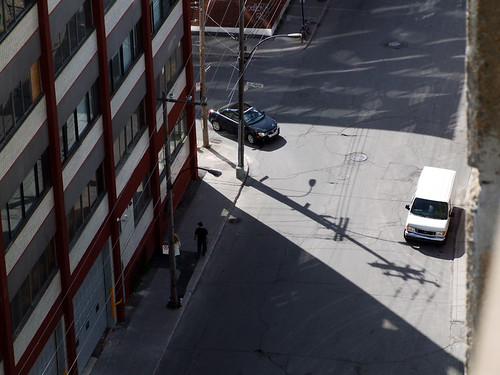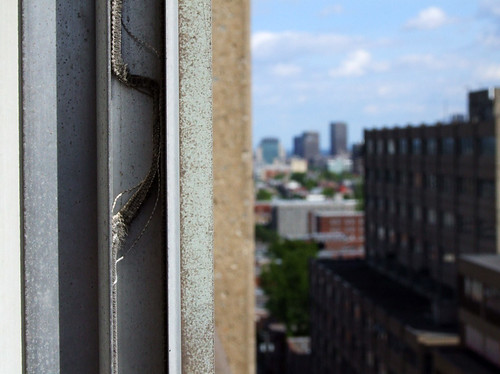In this week’s edition of the Mirror I have an article outlining some of the issues surrounding the city’s planned redevelopment of the Mile End garment district. This summer, work will begin on refurbishing the portion of St. Viateur between St. Laurent and de Gaspé; a new sidewalk will also be built on the east side of de Gaspé, where one does not currently exist. Next year, St. Viateur will be extended east from Gaspé to Henri-Julien, and after that a new footbridge will be built over the CPR tracks connecting the area to Rosemont metro.
All in all, the city will be investing around $9 million in this project, with the goal of stimulating residential and commercial development on the area’s many vacant lots. It also hopes that the improvements will convince even more companies like French gaming giant Ubisoft, which maintains a large production studio at St. Viateur and St. Laurent, to move into the area and replace its fast-declining textile industry. All of this sounds fine, except that attention must be paid to the impact of this new development on the neighbourhood’s dozens of businesses and hundreds of residents, not to mention one of the city’s largest concentrations of artists and arts-related enterprises.
In my article, I talk to city officials and some of the parties that will be affected by the redevelopment. Read more on Urbanphoto or in this week’s Mirror.
For decades, de Gaspé was a buzzing hub of textile manufacturing. In recent years, however, the number of companies involved in the garment trade has declined, according to Mayor Gérald Tremblay, by more than 26 per cent, and the number of factory jobs in the area has dropped by more than 47 per cent. Change has been in the air since the mid-1990s, when the French gaming giant Ubisoft moved its studios into an old industrial building at the corner of St. Viateur and St. Laurent, bringing new life to a district that relied on an increasingly moribund industry.
The creative nature of the area goes well beyond Ubisoft, however. After being forced out of cheap downtown lofts by development, dozens of artists sought refuge in the garment district. In just six or seven years, the number of artists, musicians and arts-and-design-related enterprises in the area has risen from virtually zero to nearly 200. In Fashion Plaza, one of the hulking industrial buildings on de Gaspé, about a quarter of its tenants are artists. (…)
For the artists who work in the area, displacement is a constant worry. Many found themselves in Mile End after being evicted from downtown lofts that were the target of ill-fated development proposals, such SLEB (Saint-Laurent-en-bas, at the corner of Ontario and St. Laurent intersection), a luxury loft project that went bankrupt.
“I don’t think there’s as much risk of that happening here,” says Mathieu Beauséjour, coordinator for the Centre d’art et de diffusion Clark, a non-profit artists’ organization on de Gaspé. “It’s still mostly manufacturers around here and even when they leave, these buildings are too big to be converted into condos. But we are still concerned about some of the changes that could occur. Gentrification is already underway—artists and bohemians are here and that’s the first sign of it. It’s not necessarily a bad thing. When a neighbourhood gentrifies, it also diversifies. It’s only when it becomes perverted, like on Mount Royal, where you can’t get a sandwich for less than $15, that it’s a problem.”
Beauséjour says that city officials—including the mayor, who visited artists during the Atelier Portes Ouvertes event in May and on another occasion more recently—appear sensitive to the area’s “artistic and cultural ecosystem.” He wonders, though, whether a more active approach is necessary. He points to Paris, which bought buildings along the once-derelict Canal Saint-Martin and turned them into subsidized space for artists.
“This is a great opportunity to recognize that this is a district with artistic potential,” says Beauséjour. “We want to stay here. We don’t want to end up on Chabanel.”



8 comments
So what has become of SLEB? Is it just standing vacant?
Will be very interested in following details of this…
SLEB has been vacant since all of the artists and other tenants were kicked out in 2002. It was partially renovated before the developer went bankrupt but rumour has it that they did such a hack job that anyone else who takes over the project has to do everything again from scratch.
Grrr, that is such a pity. I fear that a lot of the condo projects being thrown up now might end up slums in a decade or so, as they haven’t necessarily been respecting building standards. I certainly wouldn’t want to live at the thing at the corner of avenue du Parc and Beaubien (especially on the Parc side, where it is practically “une piste de course” between Mile End and Loblaws.
Remember the débâcle of the leaky condos in Vancouver, many of which had been built on Californian plans for a much more arid climate.
And the shoddy workmanship on SLEB would make it economically impossible for SHDM or some other non-profit corporation to take it over as a social housing/work space for working artists. Such housing schemes exist in Paris (in that case going back a century) and other cities.
I remember reading something several months ago about a legal fight involving the bankrupt company, its owner and the parties trying to wrestle away the property. Meanwhile the property stands vacant, which is utterly ridiculous. This is perhaps one of the best spots in Montreal for an urban condo project and chances are it’s only going to get better when the Quartier des Spectacles project gets underway.
Does anyone know if the adjacent vacant lot (recently covered in a Potemkin move to hide a mini-Lochness lake within from city visitors during the festival season) is part of SLEB as well or SLEB is only that single building on the corner of St-Laurent & Ontario?
That’s part of SLEB too. You might remember that there were actually buildings on that lot until 2002 or 2003 — after that they were demolished to make way for the second phase of SLEB, which was to be a new condo tower. The façades of those buildings were originally supposed to be reconstructed along with the new condos but now that the development company is gone I’m not sure what’s happening with that. It’s possible that those buildings are lost forever.
That is a pity too, as there were some lovely old buildings – though run-down – in that îlot and a farsighted developer would have seen the benefits of working them into their project. I can’t imagine a much better spot for an urban condo project – especially with the new Quartier des Spectacles, the improvements in Chinatown, local general shopping close by with the large and well-stocked IGA at Complexe Desjardins etc. Hard to believe that there can be such a major screw up in a case where there is actually serious money to be made for the developer.
Yeah, sleb went bankrupt, but it has been bought by some other italian guy, and rumor has it, that he will go on with the project which is not in a bad state at all.
There was a lot of public protest against the possible extension of St-Viateur because it will draw through traffic off Parc direction North through to St-Denis. Saint-Viateur is now a lovely street, the heart of Mile-End community life in many ways, it already has too much traffic. Opening it up to Henri-Julien will do nothing positive for the St-Viateur Est area but will harm the area around St-Viateur btw Parc and St-Laurent. Like so much the Tremblay gov’t does it is all about pleasing the automobile driver and the short sighted developer and speculator as opposed to enriching communities. Over 80% of Plateau traffic is through traffic, we need to make driving through our neighbourhoods more difficult for them and not easier, then maybe, just maybe, they will leave there cars in there driveways in TMR, C-des-N, Hamstead, VS-L, and suburbs beyond. If those tax payers, voters, and donors to Tremblay’s party took public transit or rode bikes to get around imagine how quickly there would be more money for public transit and bike paths! Decent public transit with airconditioning and tramways so that more people would be tempted to leave their cars at home. And not just more bike paths but safer ones too that are not just used to simplify double parking.
I know that many have been fighting this, Projet Montreal amongst them. With the municipal campaign coming up this fall I hope we can finally boot these people out and get some people in who care about our neighbourhood, people who support the arts and not just big business entertainment like the huge public subsidy to Spectra that is the farce of a ‘quartier de spectacle’.
There is so much potential in Mile-End and so much that can be done with St-Viateur Est that doesn’t jeopardize the artists, their work and the diversity of the neighbourhood.